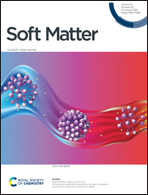Abrupt onset of the capillary-wave spectrum at wall–fluid interfaces†
Abstract
Surfaces between 3D solids and fluids exhibit a wide variety of phenomena both at equilibrium, such as roughening transitions, interfacial fluctuations and wetting, and also out-of-equilibrium, such as the surface growth of driven interfaces. These phenomena are described very successfully using lower dimensional (2D) effective models which focus on the physics associated with emergent mesoscopic lengths scales, parallel to the interface, where the 2D-like behaviour is physically transparent. However, the precise conditions under which this dimensional reduction is justifiable have remained unclear. Here we show that, for a wall–fluid interface, a dimensional reduction from 3D-like to 2D-like behaviour – identified via the decay of density correlations – occurs abruptly at a specific value of the contact angle, and indicates the beginning of interfacial-like 2D behaviour and the spontaneous onset of the capillary-wave spectrum. The reduction from 3D to 2D is characterised by the divergence of a correlation length perpendicular to the interface revealing a morphological change in the nature of density correlations. Counter-intuitive effects occur, including that 3D behaviour can persist up to the wetting temperature and also that 2D behaviour can begin when no wetting layer is present and the adsorption is negative.



 Please wait while we load your content...
Please wait while we load your content...